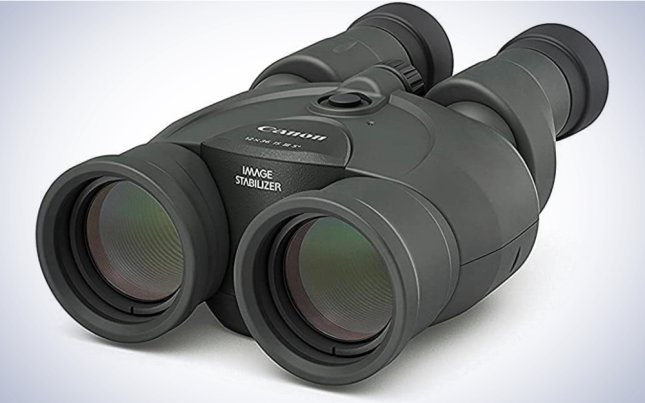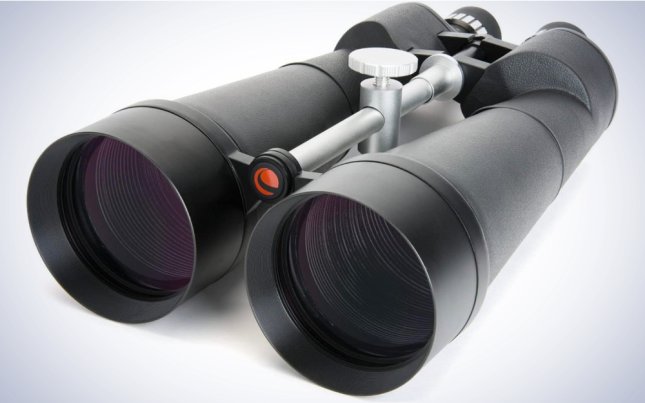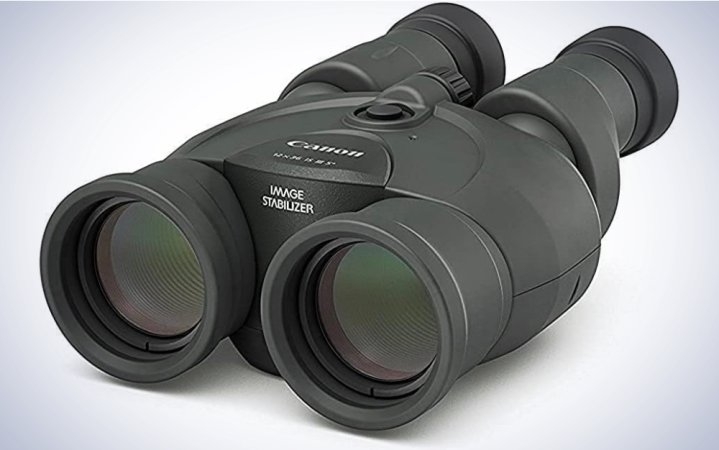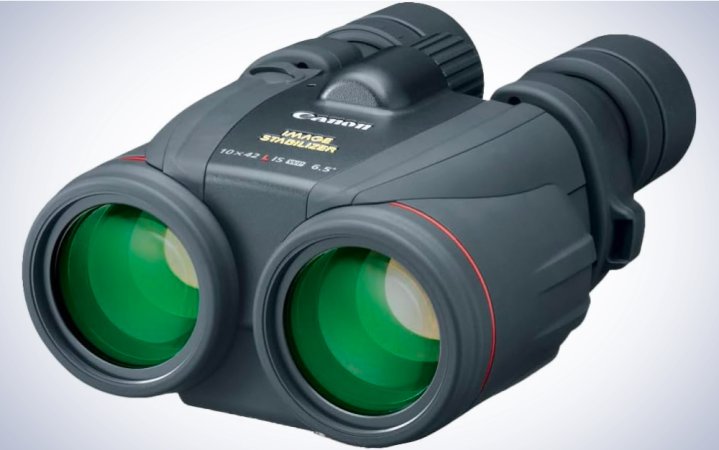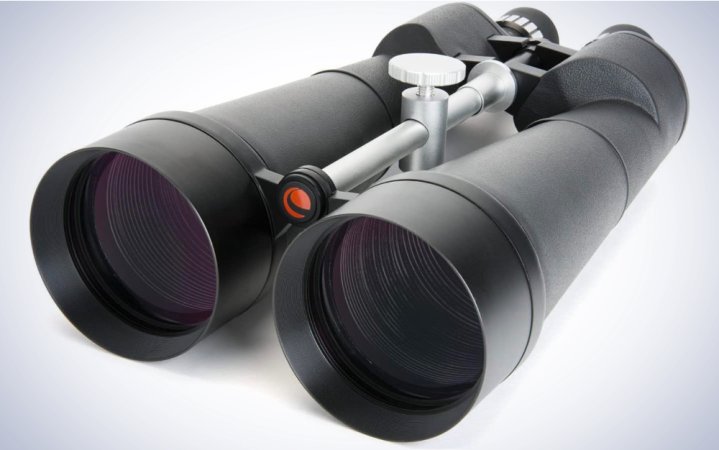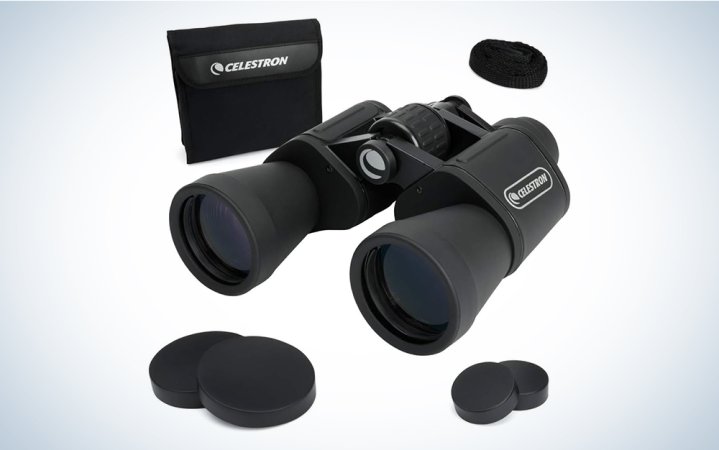We may earn revenue from the products available on this page and participate in affiliate programs. Learn more ›
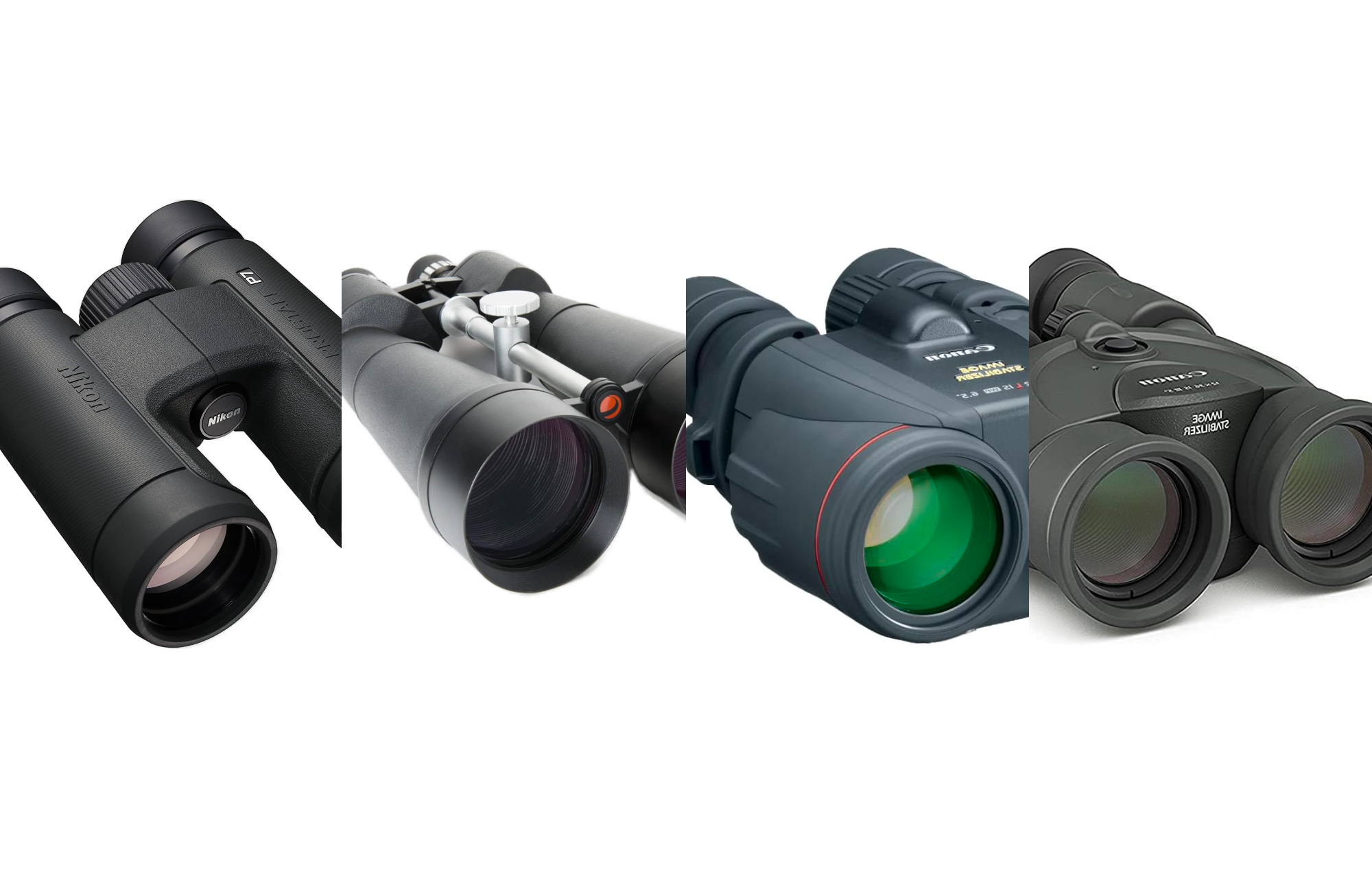
While telescopes are popular for stargazing, binoculars for astronomy offer a more portable option for gazing into the heavens. Binoculars are extremely versatile, working well for general terrestrial observations as well as more celestial surveying. You can even use them handheld or on a mount. Whether you want to observe the moon or casually stargaze, the best binoculars for astronomy are great to take into nature and bring you closer to the stars.
- Best overall: Canon 12×36 IS III
- Best splurge: Canon 10×42 L IS WP
- Best high power: Celestron SkyMaster 25X100
- Best compact: Nikon PROSTAFF P7 10×42
- Best budget: Celestron UpClose G2 10×50
How we chose the best binoculars for astronomy
Binoculars for astronomy require more specific specs than general-purpose binoculars, so we prioritized options with larger objective lens size and higher magnification. We also aimed to select options at various price points suitable for everyone from beginners to expert stargazers. While binoculars with image stabilization are excellent for astronomy use, they are quite expensive, so we’ve included models both with and without stabilization. In making our selections, we considered optical quality, size and weight, eye relief, and build quality.
The best binoculars for astronomy: Reviews & Recommendations
Binoculars for astronomy will allow you to gaze up at the moon, spot deep space objects, check out planets, and more. While these advanced optics can be used handheld, we’d recommend a tripod or mount of some variety to offer more stable, high-quality night sky views.
Best overall: Canon 12×36 IS III
Canon 12×36 IS III
Pros
- Effective image stabilization
- Relatively lightweight and compact
- Image stabilized
- Excellent optical quality
Cons
- Pricey
Specs
- Objective lens diameter: 36mm
- Magnification: 12x
- Field of view: 5 degrees
- Eye relief: 0.57 inches (14mm)
- Weight: 1.5 pounds
- Dimensions: 5 x 6.85 x 2.76 inches
Canon makes some of the best image-stabilized binoculars available, so it should be no surprise that our top pick comes from the imaging giant. The Canon 12×36 IS III binoculars for astronomy offer the company’s typical high-end optics and Porro II prisms, resulting in a sharp, bright, colorful image. It also features a double field flattener, which produces a distortion-free image.
The 36mm objective lens diameter is slightly lower than what is typically recommended for astronomy use. However, these still offer plenty of light gathering for stargazing. You’ll also be able to use them for things like bird watching, adding to their versatility. Plus, the smaller objective lens results in a more compact size ideal for most people, which is why it earned our top spot. These Canon binos provide 12x magnification, allowing you to see details on the moon’s surface.
What really makes these optics stand out is the image stabilization. Canon built these with technology similar to what they use in their EF lenses, resulting in much sharper images when holding the binoculars. You’ll need two AA batteries for power, and they will typically get up to 12 hours of use. Simply put, once you use IS binoculars, you won’t want to go back to anything else.
Best splurge: Canon 10×42 L IS WP
Canon 10×42 L IS WP
Pros
- Excellent stabilization
- High-quality optics
- Rugged build
- Plenty of eye relief
Cons
- Expensive
- Fairly heavy and bulky
Specs
- Objective lens diameter: 42mm
- Magnification: 10x
- Field of view: 6.5 degrees
- Eye relief: 0.63 inches (16mm)
- Weight: 2.4 pounds
- Dimensions: 5.4 x 6.9 x 3.4 inches
If money is no object and you want the best of the best, the Canon 10×42 L IS WP binoculars are the way to go. These powerful binoculars for astronomy offer a large objective lens of 42mm, capturing tons of light for viewing even dim celestial objects. The 10x magnification is plenty for most astronomical observations and offers plenty of eye relief for a range of users.
Like the pair mentioned above, these feature Canon’s impressive image stabilization. It will almost look like you are using a tripod, giving you sharp, clear views. The ‘L’ in the name refers to Canon’s top-tier line of optics. These feature two ultra-low dispersion (UD) lens elements (on each side), which effectively corrects for chromatic aberration. Images will be sharp, bright, and vibrant, offering excellent views of the stars.
Of course, there are downsides to these binos. First, they are expensive. If you are a casual user, they will be overkill. Second, they are fairly bulky and heavy. You likely won’t want to hold them for long periods, and they will add weight to your pack if you are hiking. But this is the pair to get if you are serious about stargazing with your binoculars.
Best high power: Celestron SkyMaster 25X100
Celestron SkyMaster 25X100
Pros
- Massive object lens diameter gathers tons of light
- Lots of magnification
- Comes with a tripod adapter
- Excellent image quality
Cons
- Very bulky and heavy
- Not for handholding
Specs
- Objective lens diameter: 100mm
- Magnification: 25x
- Field of view: 3 degrees
- Eye relief: 0.59 inches (15mm)
- Weight: 8.75 pounds
- Dimensions: 10.1 x 5.1 x 15.28 inches
Celestron is one of the top telescope producers, so it makes sense that the company would also produce top-notch binoculars for astronomy. Celestron SkyMaster 25×100 is essentially the equivalent of a telescope in your hands. It offers a whopping 25x magnification and an objective lens measuring 100mm. That massive lens will let in tons of light. Paired with the high level of magnification, you’ll see epic details in the night sky, such as Jupiter’s belts, star clusters, and more.
These binos feature BaK-4 prisms and multi-coated lenses, enhancing contrast for superb viewing quality. They are ruggedly built with a water-resistant design. The SkyMaster also utilizes a rubber-armored housing, which protects them from damage and provides a better grip.
Unfortunately, such power comes with great responsibility. In this case, that means lots of weight. The SkyMaster weighs 8.75 pounds and, naturally, is larger than any other option on our list. They also don’t offer any image stabilization. As a result, you won’t want to hold these by hand for very long. Luckily, it has a built-in tripod adapter, making it easier to hook up to a tripod for hands-free use. All of this also comes at a rather reasonable price, so you don’t have to break the bank to see craters on the moon.
Best compact: Nikon PROSTAFF P7 10×42
Nikon PROSTAFF P7 10×42
Pros
- Compact and lightweight
- Waterproof and fogproof
- Adjustable eyecups and long eye relief
- Versatile
Cons
- No tripod adapter
Specs
- Objective lens diameter: 42mm
- Magnification: 10x
- Field of view: 7 degrees
- Eye relief: 0.62 inches (15.7mm)
- Weight: 1.3 pounds
- Dimensions: 5.91 x 5.12 x 2.17 inches
Weight is an important consideration when backpacking or hiking, even when you hope to take advantage of the dark skies. That’s where the Nikon PROSTAFF P7 binoculars come into play. They are very compact and lightweight, coming in at just 1.3 pounds and just under six inches long. It will be much easier to bring them along on your trips. And, it will be easier to hold for longer viewing sessions as well.
The PROSTAFF P7 are also ruggedly built and suited for adventures. They are waterproof to 3.3 feet and nitrogen-filled for fogproof performance. The 0.62-inch eye relief works well for those who wear glasses, and the turn-and-slide eyecups are adjustable to work well for a group of people. A rubber-armored body protects from drops and bumps and makes them easier to hold. Nikon used a water- and oil-repellent coating on both the objective and eyepiece lenses, which helps keep them free of water and fingerprints.
Although these are not specifically designed for stargazing, they will definitely do the job. The 10x magnification is enough for casual night sky viewing, and the 42mm objective lens will gather plenty of light. Nikon designed these with high-quality optics and Phase-Correction coating for superb image quality and clarity. It also features a dielectric high-reflective multilayer prism coating, which maximizes light transmission. Finally, the locking diopter ring, typically only found on much more expensive optics, keeps your setting locked in.
Best budget: Celestron UpClose G2 10×50
Pros
- Very affordable
- Water-resistant
- Rubber coating prevents slips
- Good optical quality
Cons
- Requires collimation
- Not nitrogen-filled
Specs
- Objective lens diameter: 50mm
- Magnification: 10x
- Field of view: 6.8 degrees
- Eye relief: 0.47 inches (12mm)
- Weight: 1.69 pounds
- Dimensions: 8 x 7 x 2.5 inches
You don’t have to spend a fortune to get started with binoculars for astronomy. This budget-friendly pair also happens to be great for beginner stargazers. They are compact and lightweight, making them ideal binoculars for hiking. Yet they still offer 10x magnification and a 50mm objective lens. Those specs will allow you to see the moon in all its glory easily, as well as some star clusters and more.
Celestron built these with a rugged design, including a rubber coating to protect from drops and improve grip. They are water resistant, so you won’t need to panic if you get caught in a rain shower. They are not nitrogen-filled, though, so they tend to fog up.
The main downside to this budget set of binos is that they require collimation—the alignment of the lenses. While not difficult, it does take time away from your stargazing. The good news is that Celestron used multi-coated optics, which results in a quality image with good contrast and mostly accurate color. If you are just getting started or want some kid-friendly binoculars for astronomy, these will do a great job.
What to consider when shopping for the best binoculars for astronomy
Binoculars are, for the most part, rather simple devices without much in the way of fancy technology. But, there is some specific lingo that you should be aware of when shopping for binoculars for astronomy to ensure you pick the right optics for viewing the night sky.
Magnification
All binoculars include two numbers in the name, such as 10×50. The first number refers to magnification. For stargazing, you’ll typically want at least 10x magnification. If you want to see the moon or planets in more detail or search for smaller deep space objects, 12x will be better. However, remember that more magnification will exaggerate movement while holding the binoculars. So, if you will only handhold the binos, we suggest sticking to 10x or lower.
Objective lens
The second number tells you the size of the objective lens, measured in millimeters. In our example above, that would be 50mm. The objective lens is the lens closest to the object you’re viewing, or the one opposite of the eyepieces. This number tells you how large the binoculars are and how much light they let in.
Larger objective lenses collect more light, which is better for stargazing. But it also means larger binoculars, which makes them harder to handhold. As a result, you’ll need a balance unless you only plan on using a tripod or mount of some type. For astronomy use, you’ll want at least 40-50mm, though 50-60mm will allow you to see fainter celestial objects.
Image stabilization
If you’ve ever spent time looking through binoculars, you may have noticed how hard it is to keep them steady. That movement gets even more dramatic in higher-powered binoculars for astronomy, which can make detailed observations quite challenging. If you want superb image quality and don’t always want to rely on a tripod, look for a pair of image-stabilized binoculars.
There are different types of image stabilization in binos. Some offer passive stabilization (also called mechanical stabilization) with suspended prisms, which don’t require any batteries. Other types of stabilization include digital, optical, and hybrid stabilization (a combination of digital and optical). Each type has pros and cons, though hybrid stabilization offers the best results, albeit at the highest cost.
Roof prism vs. Porro prism
There are two varieties of binocular design: Roof prisms and Porro prisms. In Porro prism binoculars, the objective lens is offset from the eyepiece, requiring the light to travel in a zig-zag pattern. This design can result in a higher quality image, but they are bulky and heavy compared to roof prism binos.
The prisms in Roof prism binoculars line up closely, allowing the objective lens to be in a straight line from the eyepiece. The Roof prism design results in a more compact, lightweight form factor. However, it is a more complicated design, which results in a much higher price tag compared to Porro prism binoculars.
Exit pupil
Exit pupil refers to the round, bright image you see when looking through the eyepiece. The larger the diameter, the brighter the image, which is important for astronomy. To calculate this, divide the objective lens diameter by the magnification. So, for example, a 10×50 binocular would offer an exit pupil of 5mm.
The key here is to find binoculars for astronomy with an exit pupil roughly the same size as the human pupil when dilated for darkness. In dark conditions, most pupils dilate to around 7mm. Opting for binoculars with an exit pupil of 2.5mm will make the image look quite dark.
Eye relief
Eye relief is the distance from the eyepiece lens to the exit pupil, where the image is formed. Put simply, it is how far you can hold the binoculars away from your eyes and still see the full image without vignetting. If you wear glasses, you’ll need binoculars with longer eye relief. Be sure to go with an eye relief greater than 14mm if you use glasses.
Weight
Weight might not be the first thing that comes to mind when choosing binoculars for astronomy. However, it can be incredibly important. If you plan on handholding your binoculars, look for a more compact, lightweight option. Otherwise your arms will tire quickly, but more importantly, they will be hard to hold steady. And if you can’t hold them steady, you won’t get a very good view of the night sky.
If you opt for a heavier option or plan long observation sessions with high magnification, we recommend mounting the binoculars to a tripod.
FAQs
Binoculars with 10x magnification and an objective lens of 50mm (10×50) are the most popular option for astronomy, thanks to the balance of size and magnification. However, if you want to see objects in more detail or hope to view faint deep space objects, something like 15×70 or larger is best.
Depending on the objective lens and magnification on your binoculars, you’ll be able to use them to view the moon, planets, star clusters, nebulae, and even some galaxies.
While you can certainly look up at the stars with any binoculars, not just any pair will allow for in-depth astronomy. For astronomy use, you’ll need optics that are able to gather plenty of light and offer higher magnification than general use. Budget and travel-friendly binoculars typically won’t make the cut as a result.
How much you should spend on binoculars for astronomy depends on how you plan on using them and what you hope to view. For beginners, a few hundred dollars is plenty. For those wanting epic night sky views, you’ll want to spend closer to $1,000 for high-quality optics, impressive image stabilization, and plenty of light-gathering abilities.
Final thoughts on the best binoculars for astronomy
- Best overall: Canon 12×36 IS III
- Best splurge: Canon 10×42 L IS WP
- Best high power: Celestron SkyMaster 25X100
- Best compact: Nikon PROSTAFF P7 10×42
- Best budget: Celestron UpClose G2 10×50
Binoculars for astronomy can serve as an excellent alternative to bulky telescopes. These optics allow you to view celestial objects on the go, making it a great choice for camping, hiking, or travel of any type. Binoculars are also easier to store, which is ideal for those living in smaller spaces. Despite their convenience, they still allow you to see plenty of wonders in the night sky.
